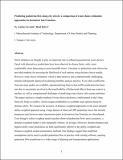Predicting pedestrian flow along city streets: a comparison of route choice estimation approaches in downtown San Francisco
Author(s)
Sevtsuk, Andres; Kalvo, Raul
DownloadPredicting pedestrian flow_Sevtsuk Kalvo 2020_IJST.pdf (1.798Mb)
Open Access Policy
Open Access Policy
Creative Commons Attribution-Noncommercial-Share Alike
Terms of use
Metadata
Show full item recordAbstract
Street attributes are thought to play an important role in influencing pedestrian route choices. Faced with alternatives, pedestrians have been observed to choose faster, safer, more comfortable, more interesting or more beautiful routes. Literature on pedestrian route choice has provided methods for assessing the likelihood of such options using discrete choice models. However, route choice estimation, which is data intensive and computationally challenging, remains infrequently deployed in planning mobility analysis practice. Even when coefficients from previous studies are available, operationalizing them in foot-traffic predictions has been rare due to uncertainty involved in the transferability of behavioral effects from one context to another, as well as computational challenges of predicting route choice with custom attributes. This paper explores a simpler method of route choice prediction, implemented in the Urban Network Analysis toolbox, which assigns probabilities to available route options based on distance alone. We compare the accuracy of distance-weighted approaches to the more detailed utility-weighted approach using a large dataset of observed GPS pedestrian traces that include numerous trips between same intersections pairs in downtown San Francisco as a benchmark. Even though a utility-weighted model matches observed pedestrian flows most accurately, a distance-weighted model is only marginally inferior, on average. However, shortest-distance and highest-utility route predictions are both significantly inferior to the utility-weighted and distance-weighted sample-enumeration methods. Our findings suggest that simplified assumptions can be used to predict pedestrian flow in practice with existing software, opening pedestrian flow predictions to a wider range of planning and transportation applications.
Date issued
2021Department
Massachusetts Institute of Technology. Department of Urban Studies and Planning; Massachusetts Institute of Technology. School of Architecture and PlanningJournal
International Journal of Sustainable Transportation
Citation
Sevtsuk, Andres and Raul Kalvo. "Predicting pedestrian flow along city streets: a comparison of route choice estimation approaches in downtown San Francisco." Forthcoming in: International Journal of Sustainable Transportation.
Version: Author's final manuscript